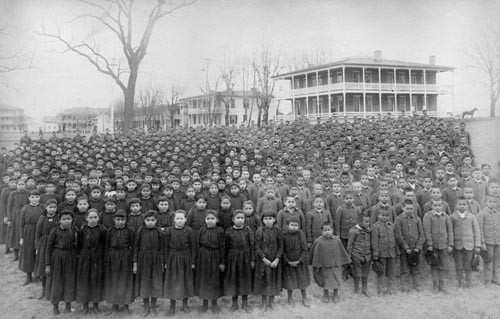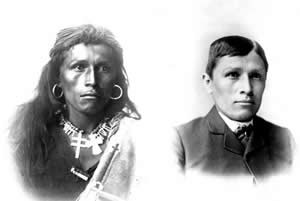Carlisle Indian Industrial School
Introduction
Text-to-speech Audio
At the beginning of the 20th century, the government funded schools for Native American children were used to assimilate them into white society. One such school, the Carlisle Indian Industrial School, opened in 1879 in Carlisle, Pennsylvania. Because the Carlisle campus had been previously procured from the Department of War for use as an army barrack, the area was not on a reservation. Therefore, the school was the first federal government non-reservation Native American boarding school.
Status as a non-reservation school allowed the administration to strip traditional heritage from the students. For example, students often wore military uniforms and marched in drills. Also, the Native Americans were prohibited to speak their native language or wear their native clothing.
Administrators would send students to the homes of caucasians in the community, and were expected to learn trades. The Native American students were also expected to become more like the caucasians and less like their Native relatives.
Images
Photo of students at Carlisle, 1892

A student before and after his time at Carlisle

Historical Marker

Backstory and Context
Text-to-speech Audio
Carlisle is often best-remembered for its athletic programs, and the school decided that athletics needed to be an aspect of the school experience. Because of sport popularity in this period, the the school administrators probably viewed athletics as a way to make the natives more "civilized."
Other changes were going on within the United States during this period. There was a shift of the population, and the fringed wilderness was depleting. The roughness that had been prevalent in earlier times was given way to team sports. There was a population movement from rural areas to more urban settings, which also created additional opportunities for communities, colleges, and workforce teams to play sports against one another.
The increase and popularity inevitably led to an increase in both games and the location of where games were played. There was a large increase in the amount of stadiums that were built. City density led to public demand of more parks and open spaces, which also played a role in the growth of playing fields and stadiums during this time.
Though Carlisle was not located in a metropolitan area, the administrators likely recognized some of these external factors. They believed football would also give exposure to the school.
Other changes were going on within the United States during this period. There was a shift of the population, and the fringed wilderness was depleting. The roughness that had been prevalent in earlier times was given way to team sports. There was a population movement from rural areas to more urban settings, which also created additional opportunities for communities, colleges, and workforce teams to play sports against one another.
The increase and popularity inevitably led to an increase in both games and the location of where games were played. There was a large increase in the amount of stadiums that were built. City density led to public demand of more parks and open spaces, which also played a role in the growth of playing fields and stadiums during this time.
Though Carlisle was not located in a metropolitan area, the administrators likely recognized some of these external factors. They believed football would also give exposure to the school.
The beginning of football at Carlisle had little fanfare or expectations, and was not the first athletic adventure for the school. The first year of football at Carlisle occurred in 1893 and only featured a season of two games. The 1880s and 1890s saw greater growth in football popularity, which was likely due to higher moral regarding football in Carlisle.
In 1896, Carlisle hired a coach rather than using volunteers, and the team played against Brown, Connecticut, Harvard, Pennsylvania, Penn State, Princeton, Wisconsin, and Yale. That season, Carlisle won six games and public interest in the team grew.
In 1896, Carlisle hired a coach rather than using volunteers, and the team played against Brown, Connecticut, Harvard, Pennsylvania, Penn State, Princeton, Wisconsin, and Yale. That season, Carlisle won six games and public interest in the team grew.
The Carlisle Indian School was poised for further greatness in the late 1890s. Carlisle chose to hire Glenn "Pop" Warner to be the coach in 1899. Walter Camp, the Yale head coach, wrote a letter of recommendation for Warner, who in his first years was paid an annual salary of $1,200. Meeting his team for the first time, Warner told the team he envisioned them being a national power.
Warner's first year coaching was successful. However the biggest game of the season was against the tremendously successful Penn on October 13th, 1899. Penn had won sixty five of sixty seven games the previous five years. During this game, however, the atmosphere was livid and 22,000 people showed up for the game. The result was an impressive Carlisle win, 16-5.
Warner's first year coaching was successful. However the biggest game of the season was against the tremendously successful Penn on October 13th, 1899. Penn had won sixty five of sixty seven games the previous five years. During this game, however, the atmosphere was livid and 22,000 people showed up for the game. The result was an impressive Carlisle win, 16-5.
The arrival of Jim Thorpe allowed Carlisle to increase its success. The 1911 Harvard match is considered one of the greatest ever. Thirty thousand people attended the game at Harvard Stadium. An injured Thorpe kicked multiple field goals, but the unveiling of the reverse play was the key to Carlisle's win. In the end, Thorpe kicked the winning field goal and Carlisle won 18-15. They lost the last game of the season to Syracuse for their only loss, and finished the season with eleven wins and one defeat.
In 1912, Carlisle became the highest scoring team in the country, averaging nearly fifty points a game in the first four games. Carlisle had also revolutionized a form of a hurry up offense. This tactic tired their opponents as there wasn't a pause for a huddle, and the quarterback made adjustments at the line of scrimmage, at times using Indian signs to communicate to the team. They went into the game against Army with a 10-0-1 record, and the highly touted Army team lost to Carlisle 27-6.
That year Thorpe scored 25 touchdowns and a record 198 points. However, there was evidence that when Thorpe was away from Carlisle he had collected $15.00 a week, which equated to him playing pro ball. This was the beginning of decline for Carlisle football.
That year Thorpe scored 25 touchdowns and a record 198 points. However, there was evidence that when Thorpe was away from Carlisle he had collected $15.00 a week, which equated to him playing pro ball. This was the beginning of decline for Carlisle football.
Cite This Entry
Newcomer, Daniel, Keith Durst, and Clio Admin. "Carlisle Indian Industrial School." Clio: Your Guide to History. May 14, 2015. Accessed July 26, 2025. https://theclio.com/entry/14660
Sources
Bibliography
Anderson, Lars. 2007. Carlisle Vs. Army: Jim Thorp, Dwight Eisenhower, Pop Warner, and The Forgotten Story. New York, NY: Random House, Inc.
Bird, Elizabeth. 1996. Dressing in Feathers: The Construction of The Indian in American Pop Culture. Boulder, Co: Westview Press.
Jenkins, Sally, interview by John Ydstie. 2007. Gridiron Guts (May 19).
—. 2007. The Real All Americans: The Team That Changed A Game, A People, A Nation. Doubleday.
Oxendine, Joseph B. 1988. American Indian Sports Heritage. Champaign, Illinois: Human Kinetics Books.

